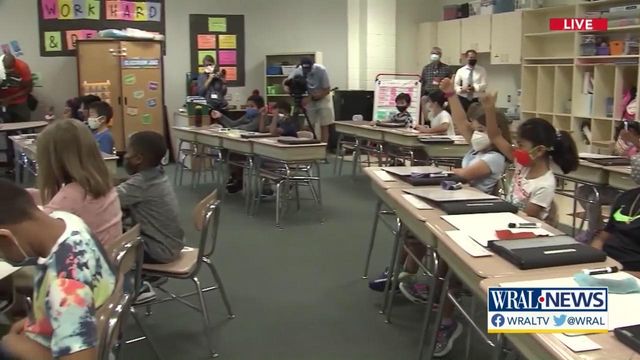Universal masking in schools shown to reduce spread of COVID-19, study finds
A study published Wednesday by the ABC Science Collaborative foundschools with required masking had 72% less within-school spread of COVID-19 compared to schools with optional masking.
Posted — UpdatedA study from the Durham-based ABC Science Collaborative found school districts that required masking saw lower COVID-19 transmission within schools last fall compared to those with optional masking policies.
“The results of this study clearly show that universal masking reduces school transmission of COVID-19 when compared to optional masking, a finding that is consistent with earlier data,” said Dr. Danny Benjamin, a co-chair of the ABC Science Collaborative and distinguished professor in the Department of Pediatrics at Duke University School of Medicine.
The study included 61 school districts, 1,112,899 students and 157,069 staff members. Six districts had optional masking policies, nine had partial masking policies, and 46 had universal masking.
Doctors performed the study from July 26, 2021, to Dec. 13, 2021, during a period of the COVID-19 pandemic when the delta variant was the predominant variant. Data collection ended at the start of the omicron variant surge in the U.S.
The districts reported 40,601 community-acquired infections (36,032 among students, 4,569 among staff) and 3,085 in-school infections (2,844 among students, 241 among staff).
“As more students have returned to school, masking and vaccination of children 5 years and older have remained the most practical and effective mitigation strategies to keeping students healthy and learning in-person,” Benjamin said.
Districts that made mask optional throughout the study period had 3.6 times the rate of in-school transmission compared to those that required universal masking. For every 100 community-acquired cases, districts with a mask mandate had 7.3 predicted secondary infections, while Those that made masks optional had 26.4.
“The definitive metric of interest in determining the safety of in-person instruction is the proportion of total infections in a school community that are attributed to within-school (secondary) transmission,” the study states. “This metric is also critical to help districts determine the direct impact of individual mitigation strategies and policies.”
The study gave participating school districts tools for monitoring the success of their mitigation measures and evaluating policies based on the needs of their communities.
“Maintaining in-person instruction is critical for children,” said Dr. Kanecia Zimmerman, co-chair of the ABC Science Collaborative and associate professor of pediatrics at Duke. “Providing districts with the ability to monitor transmission data in real time and in response to changing policies allows them to shape their mitigation efforts during an evolving pandemic.”
Related Topics
• Credits
Copyright 2024 by Capitol Broadcasting Company. All rights reserved. This material may not be published, broadcast, rewritten or redistributed.






